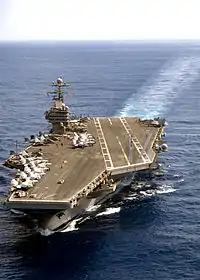Operation Maritime Guard
Operation Maritime Guard was a NATO blockade, in the international waters of the Adriatic Sea, of the former Yugoslavia.[1][2][3]
| Operation Maritime Guard | |
|---|---|
| Part of the NATO intervention in Bosnia | |
 USS Theodore Roosevelt, which participated in Operation Maritime Guard | |
| Objective | Blockade the former Yugoslavia. |
| Date | November 22, 1992 – 1993 |
| Executed by | |
Scope
The operation began on November 22, 1992.[4][5] It followed NATO Operation Maritime Monitor, and was in support of UN Security Council Resolution 787, which called upon states acting individually or otherwise to enforce the UN embargoes of the former Yugoslavia ("calls upon States ... to use such measures commensurate with the specific circumstances as may be necessary" to enforce the embargo).[1][2][4][6][7]
It authorized NATO to use force, and included stopping, inspecting, and diverting ships bound for the former Yugoslavia.[5][8] All ships bound to or coming from the territorial waters of the former Yugoslavia were halted for inspection and verification of their cargoes and destinations.[9]
With support from Turkey, the Netherlands, and Germany, the operation was strengthened to allow for NATO aircraft to shoot down aircraft that violated the blockade.[10] An article in the academic journal International Affairs stated that Operation Maritime Guard was: "the first authorized use of force to back a UN Security Council resolution".[11]
In April 1993, a NATO official said that warships would shoot if necessary to stop a ship to enforce the blockade, with inert munitions which could include machine gun bullets and armor-piercing cannon shells.[12][13]
Forces and results
The blockade comprised destroyers from Turkey, Italy, Germany, Greece, and the United Kingdom, and frigates from the United States and the Netherlands, assisted by NATO Maritime Patrol Aircraft.[14][15] The frigate USS Kauffman and aircraft carrier USS Theodore Roosevelt were among the warships that took part in the operation.[16][17] AWACS supported the effort with its sophisticated maritime radar by providing blockading ships with long-range sea surveillance coverage.[18]
The blockade was directed by the Commander-in-Chief Allied Forces Southern Europe, U.S. Admiral Mike Boorda.[1]
Under the blockade, 12,367 ships were contacted, 1,032 of them were inspected or diverted to a port to be inspected, and 9 ships were found to be violating the UN embargoes.[1]
Successor
Its successor was Operation Sharp Guard. That was a multi-year joint naval blockade in the Adriatic Sea by NATO and the Western European Union on shipments to the former Yugoslavia that began on June 15, 1993, was suspended on June 19, 1996, and was terminated on October 2, 1996.[19][20][21][22]
References
- John Pike. "Operation Maritime Guard". Globalsecurity.org. Retrieved June 8, 2010.
- Ugo Caruso (2007). "The Interplay between Council of Europe, OSCE, EU and NATO" (PDF). Archived from the original (PDF) on June 12, 2010. Retrieved June 8, 2010.
- "Peace-Keeping Operations: Requirements and Effectiveness; NATO's Role" (PDF). June 2001. Retrieved June 8, 2010.
- Jennifer Medcalf (2005). NATO: a beginner's guide. Oneworld Publications. Retrieved June 8, 2010 – via Internet Archive.
operation maritime guard.
- Kaufman, Joyce P. (2002). NATO and the former Yugoslavia: crisis, conflict, and the Atlantic Alliance. ISBN 9780742510227. Retrieved June 8, 2010.
- Craig H. Allen (2007). Maritime counterproliferation operations and the rule of law. ISBN 9780275996987. Retrieved June 8, 2010.
- John Pike. "Operation Maritime Monitor". Globalsecurity.org. Retrieved June 8, 2010.
- Regional Organizations. The Air Force Law Review. 1997. Retrieved June 8, 2010.
- "Interoperability of U.S. and NATO Allied Air Forces: Supporting Data and Case Studies", RAND, 2003
- Giovanna Bono (2003). NATO's 'peace-enforcement' tasks and 'policy communities,' 1990-1999. ISBN 9780754609445. Retrieved June 8, 2010.
- "NATO: from Kosovo to Kabul" Archived 2011-07-12 at the Wayback Machine, 2009
- "Toledo Blade - Google News Archive Search". news.google.com. Retrieved 2016-03-25.
- "The Times-News - Google News Archive Search". news.google.com. Retrieved 2016-03-25.
- James Gow (1997). Triumph of the lack of will: international diplomacy and the Yugoslav War. Columbia University Press. p. 130. Retrieved June 8, 2010 – via Internet Archive.
operation maritime guard.
- "Lessons From Bosnia: The IFOR Experience", 1998
- "USS Kaufmann: Command History for Calendar Year 1993", 1994
- "The Argus-Press - Google News Archive Search". news.google.com. Retrieved 2016-03-25.
- "NATO AWACS: Alliance Keystone for Out-of-Area Operations". Journal.forces.gc.ca. Retrieved June 8, 2010.
- Bruce A. Elleman; S. C. M. Paine (2007). Naval coalition warfare: from the Napoleonic War to Operation Iraqi Freedom. ISBN 9780415770828. Retrieved June 7, 2010.
- Bellamy, Christopher (June 20, 1996). "Naval blockade lifts in Adriatic". London: The Independent. Retrieved June 7, 2010.
- "NPR : Transcripts Search Results".
- Peter L. Hays; Brenda J. Vallance; Alan R. Van Tassel (1997). American defense policy. JHU Press. p. 533. Retrieved June 7, 2010 – via Internet Archive.
operation sharp guard.
External links
| Wikisource has original text related to this article: |

